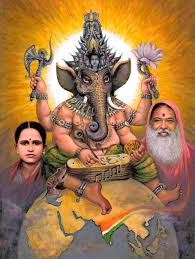Śri Ganeśāya namaḥ
Śri saraswatye namaḥ
Śri Pādavallabha Nṛsimha Saraswati
Śri Guru Dattatreyaya namaḥ.
After having obtained an in-depth understanding of the various shastras and other great works authored by Sri Adi Shankara Bhagawad-pādāchārya, eminent pundits and philosophers have quoted- ‘Shankara Shankara sākṣāt’ which means that Adi Shankara Bhagawad-pādāchārya swami is none other than the Supreme Lord Shiva!
From today we are going to discuss about the holy text ‘Moha Mudgara’ composed by him. ‘Mudgara’ means ‘that which dispels happiness’. ‘Moha Mudgara’ means ‘that which dispels the happiness being enjoyed by illusion (moha)’. In other words, it drives away illusion and ignorance (moha). These hymns are very much popular as ‘Bhaja Govindaṃ’ shlokas.
The doctor called ‘Sadguru’ prescribes the medicine known as spiritual teaching (upadesha) to help the devotee get rid of the disease called ‘samsāra’ (repeated re-births).
People of Kṛta Yuga (first eon) were very supremely knowledgeable persons (jnanis) who possessed deep ripened intellect. Therefore in that period, Datta Swami imparted teaching in the form of Upanishads. He composed complex texts such as ‘Avadhoota Geeta’ during this period.
Times had slightly changed by the time of Treta Yuga (second eon). For this reason Maharishi Vashistha and other great saints drew out the essence from the Upanishads and presented it to people in the form of texts such as ‘Jnana Vāshishtam’.
A significant change could be visible amongst the people by the time of Dwapara Yuga (third eon). A tremendous increase in desires could be noticed in them. 50% of the time was spent in administrative and political activities, 25% in fulfilling their personal needs and desires. Only the remaining 25% was spent towards spiritual activities. It was not just limited to this. Deceitfulness was rampant among people. The thought of engaging in selfless action (nishkāma karma) had been totally wiped away from the individual intellect.
At such a critical juncture, Maharishi Veda Vyasa divided the entire Vedas into different groups and thus made it easy for the people to learn Vedas. Likewise, as people did not have the time to read the Upanishads, he complied the ‘Brahma Sutras’ and the 18 supreme Puranas. Yet he did not obtain the resultant contentment. He then composed the holy text, Srimad Bhāgavatam, in which the entire emphasis is on the pillar called devotion (bhakti).
Everything underwent a change when Kali Yuga (4th eon) made its appearance. Life became chaotic. Human beings began to chase objects that were attractive to the eyes. Holy words such as ‘Vedas’ and ‘Upanishads’ were not to be heard even remotely. At this critical juncture Adi Shankara Bhagawad-pādāchārya swami decided to incarnate.
Adi Shankara Bhagawad-pādāchārya follows a very unique way of imparting his teachings. Through the medium of small hymns (shlokas) he passes on very insightful and profound messages. While giving a mild shock treatment to the person, he also shows him the ‘real true object’. What appears like a small hymn actually contains utmost, significant and insightful wisdom! While going through the deeper meaning contained in them the ultimate goal of life appear clearly before the eyes!
In this hymn ‘Bhaja Govindam’ he elucidates clearly those dangers from which the person should clearly stay away. He also teaches the ways through which the person can break free from those dangers. He details the ways of this world, the nature of the human beings and those matters/ objects towards which people are normally attracted. The significance of time (kala mahima) is also taught. The duties that the person should mandatorily engage in during his lifetime are taught. He teaches just as a mother would teach her child.
Without any distinction of caste, religion or gender, every individual is entitled to listen/ read this powerful teaching called ‘Bhaja Govindam’. Please listen and put into practice that what is being taught to you.
